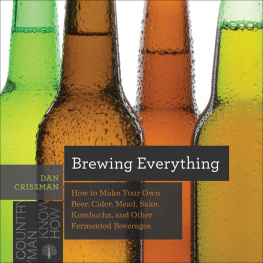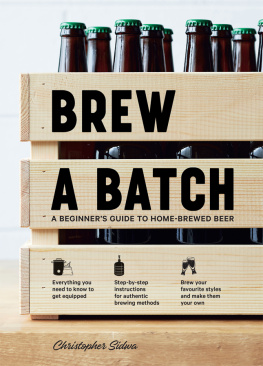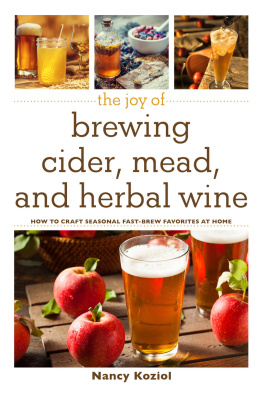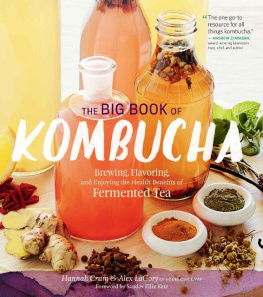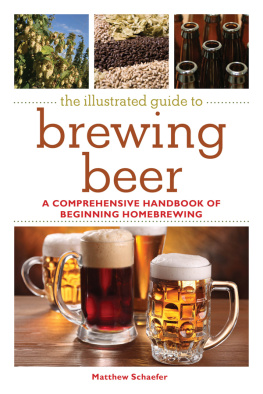

Disclaimer: This volume is intended as a general information resource. Brewing beverages at home carries certain risks, including, but not limited to, contamination of beverages from inadequate sanitization of equipment, allergic reactions to ingredients, and burns and back strain from moving heavy containers of hot liquids. See the authors note for a more detailed list of the risks and how to minimize them. As of press time, the URLs displayed in this book link or refer to existing websites. The publisher is not responsible for, and should not be deemed to endorse or recommend, any website other than its own or any content not created by it, nor is the author responsible for any third-party material.
AUTHORS NOTE
Brewing at home is incredibly fun and satisfying. But you need to always be aware of certain safety risks and to take precautions to minimize them.
ALWAYS BE SANITIZING!
Fermentation, which is the process by which beer and other drinks are brewed, literally involves growing and harnessing microbes, otherwise known as germs. This means that the brewing process does involve some risk of attracting unwanted mold or bacteria. But if you properly sanitize your equipment at the start and at each step along the way, you can minimize the risk of contamination. (Proper sanitizing also can protect against off flavors in the finished product.) Yeast, which is the key ingredient in most of these beverages, is a very strong organism, and in most conditions, as long as you are continually sanitizing, the yeast will naturally outcompete any bad bacteria.
One popular sanitizing solution that I like is an acid-based, no-rinse brand called Star San, but there are other effective products such as iodine solutions. I recommend avoiding bleach or chlorine solutions, as they can impart unpleasant aromas or flavors to the finished brew. Whichever solution you use, just follow the directions on the bottle. Most sanitizing solutions come in concentrated form: you add a small amount of the sanitizer to a bucket of water and submerge the equipment you want to sanitize for at least a few minutes. Boiling your equipment for several minutes is another way to kill anything you might not want.
MOLD: If, despite your best sanitizing efforts, you do see mold in or on one of your creations, throw the brew out immediately.
ALLERGIES TO INGREDIENTS: If youre brewing for yourself, obviously you shouldnt include any ingredient to which you know youre allergic. Beer that includes lactose should not be served to anyone who is lactose intolerant or sensitive to dairy. If you want to serve a home-brewed beverage to someone who is allergic to gluten, try cider or mead, which are naturally gluten free, unless you add malt to them.
FRESHNESS OF INGREDIENTS: Make sure bottled juice or any other packaged ingredient is not past its sale date. Examine apples and other fresh ingredients to make sure they are not stale.
EXPLODING BOTTLES: You may have heard people talk about exploding home-brew bottles. Bottles do sometimes explode, but this happens relatively rarely, and when it does happen, its generally caused by pressure building up over time, after youve set your brew aside to ferment. The risk of a bottle explosion is really quite low as long as you follow the sugar measurements given in the recipes, but I recommend storing brew bottles in a closed space to lessen the possibility of damage or injury from flying glass if an explosion does occur.
INJURIES FROM CARRYING HEAVY CONTAINERS: Large batches of beverages can be quite heavy. Use common sense to avoid back strain when you are lifting and moving pots of brew, as, for example, when transferring a pot into an ice bath.
BURNS/SCALDING: You also will be handling boiling or very hot liquid a lot, like when you transfer the contents of the pot to a sanitized bucket or glass jug or drain liquid from mash into another container. Use common sense to avoid burns: keep your face well away from steam, and wear protective clothing (e.g., oven mitts and insulated aprons) as appropriate to prevent injury.


CONTENTS
Like so many others, I got into fermentation through beer. The notion of turning four simple ingredientswater, malt, hops, and yeastinto a delicious, intoxicating beverage seemed like magic to me, and I wanted to know more about the process. So I toured some breweries, read some guidebooks, and finally worked up the nerve to brew my own. And my first try wasnt bad! (It wasnt good, either.)
Quickly, I realized that the same natural engine that gives us beer powers all kinds of other processes as well. Add a bit of yeast to apple juice, and you have hard cider. Do the same to honey and water, and you have mead. Bacteria, which weve all been raised from birth to fear, are responsible for some of the healthiest and most delicious drinks in the world.
So what is this magical thing we call fermentation? Put simply, fermentation is one of many natural processes that break down one thing into another. Fermentation is what turns cabbage into sauerkraut, milk into cheese, and a casing of ground pork into spicy soppressata. Fermentation gives bread its lift and vinegar its bite. It is a process that is happening all around us all the time. It may sound like a gross overstatement, but it is no exaggeration to say that learning how to nurture this natural phenomenon is one of the cornerstones of human civilization. Before the first refrigerator ever rolled off the assembly line, fermentation was how we kept food stable and healthy all year round.
But beyond gifting us with the holy combination of cheese and bread, fermentation is also responsible for another cornerstone of civilization: alcohol. The basic outlines are simple: Sugar + Water + Microbes = Alcohol + Carbon Dioxide. The term microbes encompasses yeast, bacteria, and other small organisms that do the heavy lifting of fermentation. Floating in a sweet liquid, these microbes feast on the stored energy in carbohydrate molecules, turning the sugars into booze and bubbles. The key to brewing is understanding what your chosen microbe likes to eat, at what temperature it feels most cozy, and which other organisms it plays well with. The endless variations on that equation are bounded only by your own creativity and understanding of nature.
When I realized how simple it was to do this at home, I became obsessed. Soon my kitchen became half-laboratory, with gurgling glass jugs hiding behind every cabinet door. I made my own kimchi and yogurt and lox (much to the chagrin of my better half). But fermented beverages were my real passion. It dawned on me after some trial and error that, in todays world, there are two ways to brew pretty much any fermented drink: the easy way and the hard way. Often these roughly correspond to the new way and the old-fashioned way, but there are elements of modern convenience in both. If you know how the process works, you can start wherever you want.
Next page
